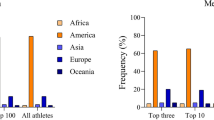Women sprinters are closing the gap on men and may one day overtake them.
Abstract
The 2004 Olympic women's 100-metre sprint champion, Yuliya Nesterenko, is assured of fame and fortune. But we show here that — if current trends continue — it is the winner of the event in the 2156 Olympics whose name will be etched in sporting history forever, because this may be the first occasion on which the race is won in a faster time than the men's event.
Similar content being viewed by others
Main
The Athens Olympic Games could be viewed as another giant experiment in human athletic achievement. Are women narrowing the gap with men, or falling further behind? Some argue that the gains made by women in running events between the 1930s and the 1980s are decreasing as the women's achievements plateau1. Others contend that there is no evidence that athletes, male or female, are reaching the limits of their potential1,2.
In a limited test, we plot the winning times of the men's and women's Olympic finals over the past 100 years (ref. 3; for data set, see supplementary information) against the competition date (Fig. 1). A range of curve-fitting procedures were tested (for methods, see supplementary information), but there was no evidence that the addition of extra parameters improved the model fit significantly from the simple linear relationships shown here. The remarkably strong linear trends that were first highlighted over ten years ago2 persist for the Olympic 100-metre sprints. There is no indication that a plateau has been reached by either male or female athletes in the Olympic 100-metre sprint record.
The regression lines are extrapolated (broken blue and red lines for men and women, respectively) and 95% confidence intervals (dotted black lines) based on the available points are superimposed. The projections intersect just before the 2156 Olympics, when the winning women's 100-metre sprint time of 8.079 s will be faster than the men's at 8.098 s.
Extrapolation of these trends to the 2008 Olympiad indicates that the women's 100-metre race could be won in a time of 10.57 ± 0.232 seconds and the men's event in 9.73 ± 0.144 seconds. Should these trends continue, the projections will intersect at the 2156 Olympics, when — for the first time ever — the winning women's 100-metre sprint time of 8.079 seconds will be lower than that of the men's winning time of 8.098 seconds (Fig. 1). The 95% confidence intervals, estimated through Markov chain Monte Carlo simulation4 (see supplementary information), indicate that this could occur as early as the 2064 or as late as the 2788 Games.
This simple analysis overlooks numerous confounding influences, such as timing accuracy, environmental variations, national boycotts and the use of legal and illegal stimulants. But it is also defended by the limited amount of variance that remains unexplained by these linear relationships.
So will these trends continue and can women really close the gap on men? Those who contend that the gender gap is widening say that drug use explains why women's times were improving faster than men's, particularly as that improvement slowed after the introduction of drug testing1. However, no evidence for this is found here. By contrast, those who maintain that there could be a continuing decrease in gender gap point out that only a minority of the world's female population has been given the opportunity to compete (O. Anderson, http://www.pponline.co.uk/encyc/0151.htm).
Whether these trends will continue at the Beijing Olympics in 2008 remains to be seen. Sports, biological and medical sciences should enable athletes to continue to improve on Olympic and world records, by fair means or foul5. But only time will tell whether in the 66th Olympiad the fastest human on the planet will be female.
References
Holden, C. Science 305, 639–640 (2004).
Whipp, B. J. & Ward, S. A. Nature 355, 25 (1992).
Rendell, M. (ed.) The Olympics: Athens to Athens 1896–2004 338–340 (Weidenfeld and Nicolson, London, 2003).
Gilks, W. R., Thomas, A. & Spiegelhalter, D. J. Statistician 43, 169–178 (1994).
Vogel, G. Science 305, 632–635 (2004).
Author information
Authors and Affiliations
Corresponding author
Ethics declarations
Competing interests
The authors declare no competing financial interests.
Supplementary information
Supplementary Table
Table showing the winning times of the men’s and women’s Olympic 100m sprints from 1900. Data taken from: The Olympic Museum (2003). The Olympics; Athens to Athens 1896-2004. London, Weidenfeld and Nicolson. (DOC 22 kb)
Supplementary Methods
Text providing details of the methods used for curve-fitting and the production of predicted time confidence intervals and predicted year confidence intervals. (DOC 18 kb)
Rights and permissions
About this article
Cite this article
Tatem, A., Guerra, C., Atkinson, P. et al. Momentous sprint at the 2156 Olympics?. Nature 431, 525 (2004). https://doi.org/10.1038/431525a
Published:
Issue Date:
DOI: https://doi.org/10.1038/431525a
This article is cited by
-
Sex Differences in Endurance Running
Sports Medicine (2022)
-
Do women reduce the gap to men in ultra-marathon running?
SpringerPlus (2016)
-
Gender Performance in the NCAA Rifle Championships: Where is the Gap?
Sex Roles (2016)
-
Has Athletic Performance Reached its Peak?
Sports Medicine (2015)
-
Analysis of sex differences in open-water ultra-distance swimming performances in the FINA World Cup races in 5 km, 10 km and 25 km from 2000 to 2012
BMC Sports Science, Medicine and Rehabilitation (2014)
Comments
By submitting a comment you agree to abide by our Terms and Community Guidelines. If you find something abusive or that does not comply with our terms or guidelines please flag it as inappropriate.




